April 2006 LIP of the Month
Corresponds, in part, to event #12 in LIP record database.
The High Arctic Large Igneous Province (HALIP): Evidence for an Associated Giant Radiating Dyke Swarm
Kenneth L. Buchan
Geological Survey of Canada, Ottawa, Canada, kbuchan@nrcan.gc.ca
Richard E. Ernst
Ernst Geosciences, 43 Margrave Ave., Ottawa, Canada, Richard.Ernst@ErnstGeosciences.com, and Department of Earth Sciences, Carleton University, Ottawa, Canada
[Excerpted and slightly modified from Buchan and Ernst 2006 Giant dyke swarms and the reconstruction of the Canadian Arctic islands, Greenland, Svalbard and Franz Josef Land In: E. Hanski, S. Mertanen, T. Ramo, and J. Vuollo (eds.) Dyke Swarms: Time Markers of Crustal Evolution. Balkema Publishers, Rotterdam, in press]
Abstract:
The High Arctic Large Igneous Province (HALIP) is distributed over the northern Arctic Islands of Canada, northern Greenland, Svalbard, Franz Josef Land and adjacent regions of the Arctic Ocean. Magmatic activity occurs in multiple pulses spanning at least 50 my between ca. 130 and 80 Ma. This activity includes several swarms that may have originally been emplaced as portions of a giant radiating dyke swarm and subsequently dispersed and distorted as a result of late Cretaceous-Tertiary plate tectonic processes.
Introduction
Volcanic rocks, dyke swarms and sills of Cretaceous age are scattered widely across the high Arctic (Figure 1) as illustrated in Figure 2a (present continental configuration) and Figure 2b (pre-drift configuration). They have been referred to collectively as the High Arctic Large Igneous Province (HALIP) (Tarduno 1998). They occur prominently in the Sverdrup Basin Magmatic Province (SBMP) of the northern Arctic islands of Canada, and in northern Greenland, Svalbard and Franz Josef Land.
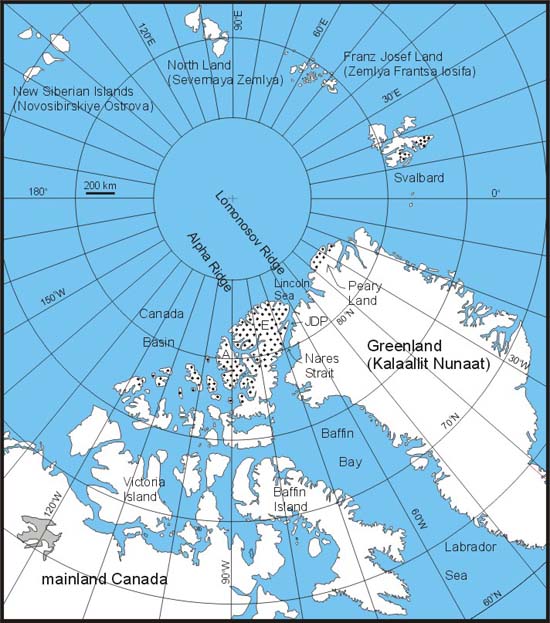
Figure 1: The Arctic region. A and E locate Axel Heiberg and Ellesmere islands, respectively. JDP is Judge Daly Promontory. The Lincoln Sea is underlain by the continental shelf of northeastern Ellesmere Island as discussed in the text. Dotted pattern indicates areas of deformation associated with the Eurekan Orogeny in the Arctic islands of Canada and northern Greenland, and the West Spitzbergen fold-thrust belt of Svalbard.
Canadian Arctic Islands
Most dykes of the SBMP radiate across the Queen Elizabeth Islands (Fig. 2a, c; Embry and Osadetz 1988, Forsyth et al. 1990 and Ernst and Buchan 1997) from a focus above a possible mantle plume centre near the southern end of the Alpha Ridge. Furthermore, Maher (2001) has noted that the Cretaceous dykes of northern Greenland, Svalbard and Franz Josef Land also have a sub-radial pattern that focuses on the Alpha Ridge. This is not obvious in the present continental configuration of Figure 2a, but will become clearer in the context of the reconstruction of Figure 2b that is discussed below. The Alpha Ridge has been interpreted to be an oceanic plateau (e.g., Jackson et al. 1986, Maher 2001). A Late Cretaceous Ar-Ar age of 82 ±2 Ma has recently been obtained for a basalt sample from the ridge (O’Connor in Jokat 2003).
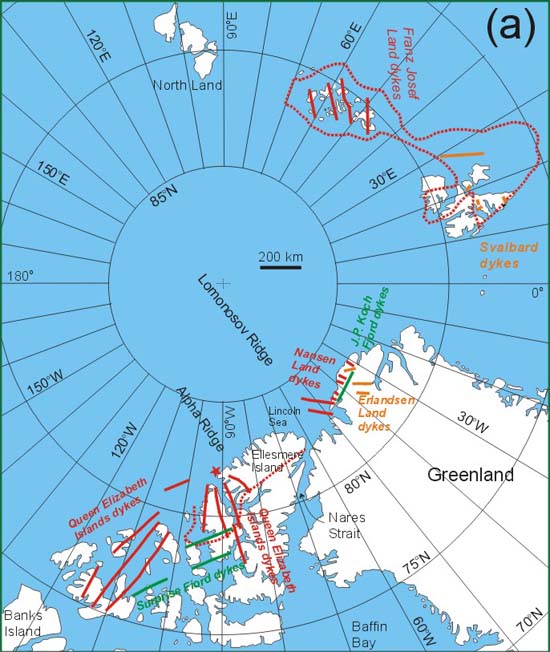
Figure 2: Cretaceous dyke swarms of High Arctic Large Igneous Province: (a) present-day coordinates; (b) Greenland, Svalbard and Franz Josef Land restored to pre-drift positions relative to mainland North America (Srivastava and Tapscott 1986, Roest and Srivastava 1989, Tessensohn and Piepjohn 2000); (c) enlargement of Queen Elizabeth Islands (Buchan and Ernst 2004); (d) enlargement of northeastern Greenland (Bengaard and Hendricksen 1986, Hendricksen 1989); (e) enlargement of Franz Josef Land (Dibner 1998). In (a) and (b) heavy dotted curve in the vicinity of Svalbard and Franz Josef Land indicates extent of Cretaceous magmatism based on seismic and aeromagnetic data (Grogan et al. 2000); in Canadian Arctic islands heavy dotted curve represents southern limit of Cretaceous volcanic rocks (Embry 1991, Fig. 14.61). In (a), (b) and (c) black star is focus of the present day distribution of dykes of Queen Elizabeth Islands radiating swarm. Open star in (b) is focus of several dykes swarms (see text). In (b) heavy coastal outline represents coast of northeastern Ellesmere Island in its present location with respect to northern Greenland. In (b) no attempt has been made to undo folding and thrusting of northeastern Arctic islands of Canada that occurred during collison with northern Greenland. In (c) A is Axel Heiberg Island. Dykes are solid lines; aeromagnetic anomalies are thin dotted lines.
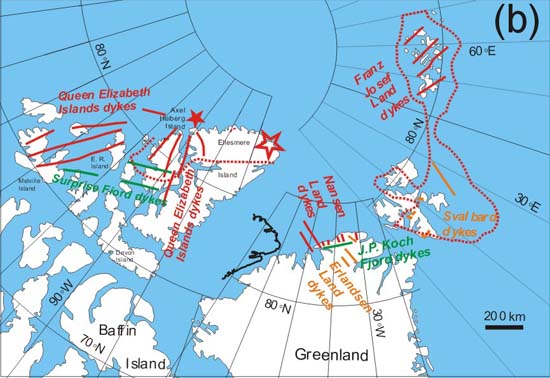
Figure 2b
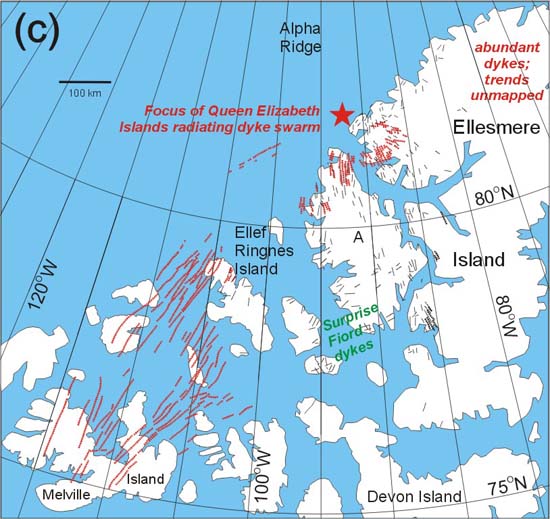
Figure 2c
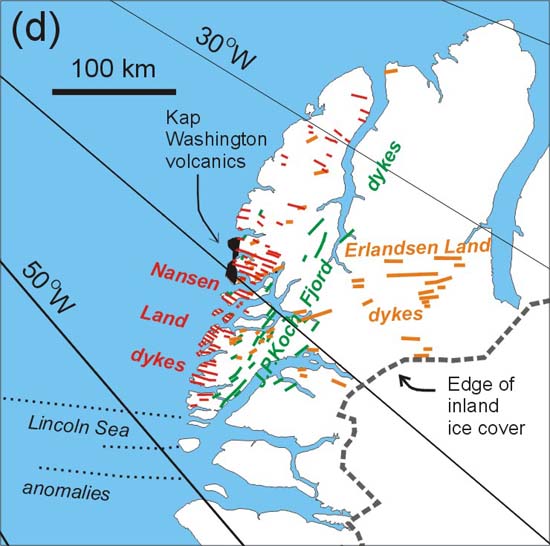
Figure 2d
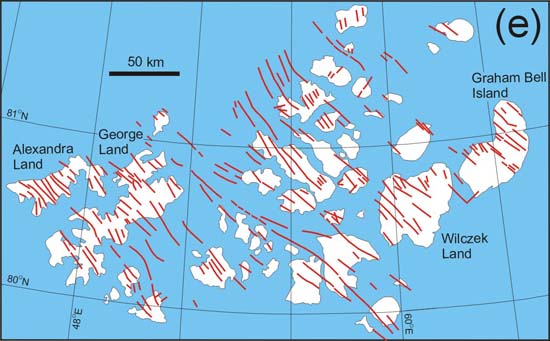
Figure 2e
The giant radiating dyke swarm of the SBMP has been referred to as the Queen Elizabeth Islands swarm (Fig. 2a) by Buchan and Ernst (2004). Key elements of this swarm include a prominent set of aeromagnetic anomalies that extend SW for 500 kms between Ellef Ringnes and Melville islands, a major S trending subswarm of dykes, the Lightfoot River dykes (named by Williamson 1988), and magnetic anomalies across Axel Heiberg Island, and SE trending dykes and magnetic anomalies in western Ellesmere Island (Balkwill and Fox 1982, Jollimore 1986, Williamson 1988). Dykes are also found farther to the east across northern Ellesmere Island (Fig. 14.61 of Embry 1991), where their trends have not been mapped. A smaller swarm of Cretaceous dykes (e.g., Thorsteinsson 1970, Jollimore 1986), called the Surprise Fiord dykes by Buchan and Ernst (2004), trends ENE and cuts across the Queen Elizabeth Island swarm at a high angle (Fig. 2a, c).
The Queen Elizabeth Islands swarm is poorly dated, with the exception of three dykes for which Ar-Ar ages are available. Villeneuve and Williamson (in press) obtained an Ar-Ar age of 128 ±3 Ma from a Lightfoot River dyke on Axel Heiberg Island, and Muecke et al. (1990) reported Ar-Ar dates of 113 ± 6 and 59 ± 1 Ma for dykes on Axel Heiberg and northern Ellesmere islands respectively. The Surprise Fiord swarm is undated.
Further insight into the possible ages of the dykes of the SBMP may be gained from the somewhat better constrained ages of the volcanic rocks. As described by Ricketts et al. (1985), Embry and Osadetz (1988), Williamson (1988), Estrada and Henjes-Kuntz (2004) and summarized in Figure 3, four distinct periods of volcanism have been recognized. Volcanic rocks of three ages have been identified stratigraphically; those in the lower portion of the Isachsen Formation (late Hauterivian to early Barremian, ca. 133-128 Ma), those in the upper portion of the Isachsen Formation (late Barremian to Aptian, ca. 128-112 Ma) and the Strand Fiord Formation volcanic rocks and approximately coeval volcanics in the Hassel Formation (late Albian to early Cenomanian, ca. 106-97 Ma). In addition, Hansen Point volcanics appear to be even younger, having been radiometrically dated at 80 ± 2 Ma (Rb-Sr isochron in Estrada and Henjes-Kunst 2004). Other reliable radiometric ages on volcanics, sills and the Wooton intrusion are broadly consistent with a pattern of prolonged magmatism (see detailed review of the radiometric dating of the volcanic rocks, dykes and sills of the SBMP in Villeneuve and Williamson (in press).
Additional constraints on the age of the dykes may be possible using geochemical comparisons with stratigraphically dated volcanic packages (M.-C. Williamson, pers. comm. 2005). For example, the earlier Isachsen and Strand Fiord volcanics have tholeiitic composition, whereas later Hansen Point volcanics are more alkaline in character (Williamson 1998; Estrada and Henjes-Kunst 2004). Dykes feeding these volcanics should have comparable chemistries, permitting older and younger dyke suites to be distinguished. More detailed geochemical classifications of HALIP units (e.g. Williamson 1998, Drachev and Saunders in press) may allow even better refinement of the ages and correlations of volcanics and intrusives.
Magnetostratigraphic results from the SBMP are also consistent with stratigraphic and radiometric dating and indicate that magmatism was long-lived. The Strand Fiord volcanics are of normal polarity (Wynne et al. 1988, Tarduno et al. 2002), consistent with emplacement during the 124-84 Ma Cretaceous Normal Magnetic Superchron. However, stratigraphically older volcanics in the Isachen Formation (Wynne et al. 1988) and probably younger volcanics (Tarduno 2003) are of reversed polarity, demonstrating that they are older and younger than the Superchron, respectively. Some dykes on northwestern Ellesmere Island are also of reversed polarity suggesting emplacement before (Jackson and Halls 1988) and (or) after the Superchron (Tarduno 2003).
Northern Greenland
In Peary Land and nearby regions of northern Greenland three Cretaceous dyke swarms have been described (Fig. 2a,d; Soper et al. 1982, Abrahamsen et al. 1997, Lyberis and Manby 2001). In decreasing age order they are the SSE-SE trending Nansen Land swarm (name used by Ernst et al. 1996), SE-ESE trending Erlandsen Land swarm and E trending J.P. Koch Fjord swarm (Fig. 3). The oldest SSE-SE trending Nansen Land dykes form a dense swarm near the coast. They cut early Cretaceous sediments (Brown and Parsons 1981, Soper et al. 1982) and in turn are crosscut by the Erlandsen Land swarm (Abrahamsen et al. 1997). Rb-Sr ages between 103 and 92 Ma have been reported for these dykes by Lyberis and Manby (2001). The SSE-SE trending Erlandsen Land dykes and E trending J. P. Koch Fjord dykes have been dated by the Ar-Ar technique at 86 ±5 Ma and 82 ±1 Ma, respectively (Fig. 3; Kontak et al. 2001). Magnetic polarities for these two swarms (Abrahamsen et al. 1997) are consistent with the radiometric ages. The Erlandsen Land swarm is dominantly of normal polarity, consistent with emplacement prior to the end of the Cretaceous Normal Magnetic Superchron at 84 Ma. The
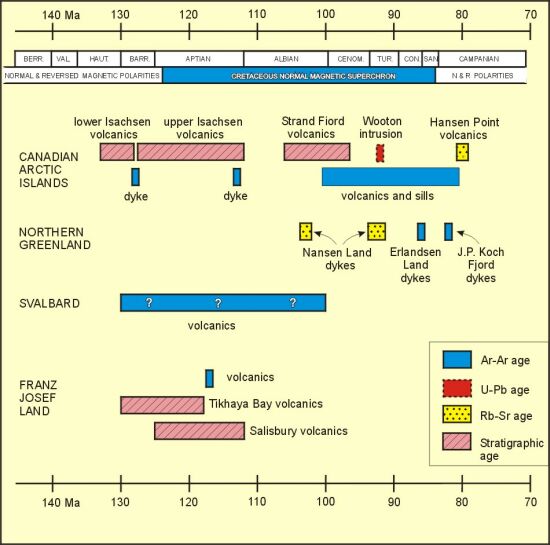
Figure 3: Summary of age constraints on Cretaceous igneous activity in the Canadian Arctic islands, northern Greenland, Svalbard and Franz Josef Land. Time scale after Gradstein et al. (2004). Stage abbreviations are Berr. (Berriasian), Val. (Valanginian), Haut. (Hauterivian), Barr. (Barremian), Cenom. (Cenomanian), Tur. (Turonian), Con. (Coniacian) and San. (Santonian). Ages based of K-Ar dating are considered to be of low reliability and therefore are not included in the figure. For the Canadian Arctic islands, stratigraphic data are summarized from Ricketts et al. (1985), Embry and Osadetz (1988) and Estada and Henjes-Kunst (2004), Ar-Ar data from Villeneuve and Williamson (in press) and references therein, U-Pb data from Trettin and Parish (1987) and Rb-Sr data from Estada and Henjes-Kunst (2004). For northern Greenland, Ar-Ar data are from Kontak et al. (2001) and Rb-Sr data are from Lyberis and Manby (2001). For Svalbard, preliminary Ar-Ar results are from Grogans et al. (2000). For Franz Josef Land, stratigraphic data are from Dibner (1998) and the Ar-Ar age from Pumhösl (1998).
J.P.Koch Fjord swarm, on the other hand, is dominantly of reversed polarity indicating emplacement after the end of the Superchron. Aeromagnetic anomalies, which likely represent the continuation of either the Nansen Land swarm or the Erlandsen Land swarm, extend northwest from the Greenland coast into the Lincoln Sea (Fig. 2a, d; Forsyth et al. 1997), which is considered to be the continental shelf extension of northeastern Ellesmere Island. This suggests that northern Greenland and the continental shelf northeast of Ellesmere Island have been linked since the time of dyke emplacement in the late Cretaceous (Forsyth et al. 1997), and that any offset along Nares Strait has been minor because the Lincoln Sea aeromagnetic anomalies appear not to be sinstrally displaced more than a few tens of kilometres relative to the onshore dykes (Fig. 2d).
Svalbard
Widespread Cretaceous sills and volcanic rocks occur in Svalbard (Tyrrell and Sandford 1933, Harland 1997, Maher 2001) and offshore to the east and south of the archipelago (Grogan et al. 2000). Only a few dykes, with a variety of trends (E-W, SE, N-S, SW) have been reported (Birkenmajer and Morawski 1960, Dallmann et al. 1993, Table 2 of Maher 2001, offshore areomagnetic anomalies described in Grogan et al. 2000). Dykes and their trends are summarized in Fig. 2b. No reliable radiometric ages are available for the dykes. K-Ar ages are mostly in the broad 135-90 Ma range (Maher 2001, Burov et al. 1976). Several dykes were studied paleomagnetically by Vincenz et al. (1981) and yielded both normal and reversed polarities. Those of reversed polarity must have been emplaced before or after the Cretaceous Normal Magnetic Superchron. Preliminary Ar-Ar dating of basalts has yielded a Barremian to Albian (ca. 130-100 Ma) age (Grogan et al. 2000).
Franz Josef Land
The Cretaceous magmatic province of Svalbard extends eastward 300 km to Franz Josef Land (Fig. 2a; Solheim et al. 1998; Grogan et al. 2000). In Franz Josef Land a prominent swarm of SE trending dykes spans the 350 km wide archipelago (Fig. 2a, e; Dibner 1998). A few dykes of other trends are also observed, as are extensive sills and volcanic flows. No reliable ages have yet been reported for the dykes. K-Ar ages for dykes and sills have a wide range between 203 and 92 Ma (Dibner 1998, p. 133-137). The age of two major packages of volcanic flows is better constrained on the basis of stratigraphy (Fig. 3; Dibner 1998, p. 72-80). The lowermost Tikhaya Formation consists mostly of basalt flows within Barremian to lower Aptian (ca. 130-118 Ma) sediments. Higher in the stratigraphy basalt flows form the upper portion of the Salisbury Formation of Aptian-Albian age (ca. 125 to 100 Ma). An Ar-Ar age of 117 ±3 Ma has also been reported for Franz Josef Land volcanics (Pumhösl 1998).
Discussion
As noted above, most HALIP dyke swarms do not have a reliable radiometric age. Nevertheless, Ar-Ar and Rb-Sr ages of 128-82 Ma indicate that Cretaceous HALIP dyke emplacement spanned a minimum of about 50 my. This conclusion is supported by magnetic polarity data, as dykes with reversed magnetizations that both predate and postdate the 124-84 Ma Cretaceous Normal Magnetic Superchron are present in the Canadian Arctic islands and northern Greenland, respectively. Stratigraphic and radiometric ages of volcanic rocks, especially in the Canadian Arctic islands, also suggests a long period of magmatism between ca. 136 and 80 Ma.
No obvious overall pattern is observed in the present configuration of HALIP dyke swarms (Fig. 2a), although most of those in the Canadian Arctic islands exhibit a broad fan as described earlier. In Figure 2b we re-map the HALIP dykes onto a Cretaceous (pre-breakup) configuration of the North American, Greenland and Eurasian plates. Several reconstructions have been proposed in the literature. In Figure 2b, we employ one of the most commonly used reconstructions. The Greenland plate and the Eurasian plate (to which both Svalbard and Franz Josef Land belong) are shown after Srivastava and Tapscott (1986) and Tessensohn and Piepjohn (2000). The reconstruction of the Greenland and North American plates follows Roest and Srivastava (1989). Note that some reconstructions of North America, Greenland and Eurasia place Svalbard somewhat farther west relative to northern Greenland (e.g., Rowley and Lottes 1988, Lawver and Scotese 1990). In addition, the amount of offset along Nares Strait and the amount of deformation that occurred in the Canadian Arctic Islands are controversial (Dawes and Kerr 1982, Johnson and Srivastava, 1982, Miall 1983, 1985, Hood et al. 1985, de Paor et al. 1989, Higgins and Soper 1989, Okulitch et al. 1990, Okulitch and Trettin 1991, Lepvrier 2000, Damaske and Oakey 2003, Oakey and Damaske 2003).
Many of the dykes shown in the reconstruction of Figure 2b form part of a broad fan suggesting that they may represent portions of a giant radiating dyke swarm. The fan includes the main swarm of Franz Josef Land, a few S to SE trending dykes of Svalbard, either (or both) of the older Nansen Land and Erlandsen Land swarms of northern Greenland and their aeromagnetic extension into the Lincoln Sea, and the western portion of the Queen Elizabeth Islands swarm (west of Axel Heiberg Island) in Canada. The approximate focus of the fan is located by an open star in Figure 2b. The eastern portion of the Queen Elizabeth Islands swarm, on Axel Heiberg Island and western Ellesmere Island, does not fit the overall radiating geometry described above. This may reflect deformation of this area during the Eurekan Orogeny (e.g. de Paor et al. 1989, Okulitch and Trettin 1991, Soper and Higgins 1991, Lyberis and Manby 2001) that followed dyke emplacement.
It is a complicated process to undo the deformation on Axel Heiberg and Ellesmere islands associated with the Eurekan Orogeny in order to relocate and realign the dyke swarms on these islands in their pre-drift configuration. In Figure 2b, we show an outline of the northeastern Ellesmere Island coastline in its present location relative to northern Greenland. This is consistent with the observation that Nansen Land or Erlandsen Land dykes of northern Greenland continue with little offset into the continental shelf extension of northeastern Greenland beneath the Lincoln Sea (Forsyth et al. 1997), and with the apparent continuity of other geological markers across Nares Strait (e.g. Dawes and Kerr 1982, Higgins and Soper 1989, Hood et al. 1985, Forsyth et al. 1997, Damaske and Oakey 2003, Oakey and Damaske 2003). If this position of northeastern Ellesmere is approximately correct prior to opening of the Labrador Sea, then it is necessary to undo a large amount of compressional deformation that occurred as Greenland moved relative to North America. This would move the dykes of Ellesmere and Axel Heiberg islands east-southeast relative to their distribution in Figure 2b. More information on the amount of offset, thrusting and block rotations of various elements of the Eurekan orogeny is required before a reliable reconstruction of this portion of the overall swarm is possible.
Paleomagnetic study of the HALIP rocks within the Eurekan Orogeny should prove helpful in reconstructing this portion of the swarm (cf. reconstruction of the Matachewan dyke swarm of the southern Canadian Shield by Bates and Halls 1991, West and Ernst 1991). To date several paleomagnetic studies have been conducted on Axel Heiberg and western Ellesmere islands. They include studies of the pre-Cretaceous volcanic rocks and sediments (Wynne et al. 1983, Ogg and Steiner 1991), HALIP volcanic rocks, sills and dykes (e.g., Wynne et al. 1988, Jackson and Halls 1985, 1988, Tarduno et al. 2002), and Cretaceous and younger sedimentary rocks (e.g., Tauxe and Clark 1987, Tarduno et al. 1997). Most of these studies have reported counterclockwise rotations of the sampling areas relative to cratonic North America, with values up to 33 ±24° (Wynne et al. 1988), although the steep nature of the Cretaceous paleomagnetic remanences results in very large uncertainties in the estimates. In addition, significant relative rotations among the various areas that have been sampled cannot be ruled out (Wynne et al. 1988). The paleomagnetic data are consistent with crustal shortening and rotation of the Axel Heiberg and western Ellesmere area in the Eurekan Orogeny as Greenland converged on the Arctic islands (Wynne et al. 1988, Jackson and Halls 1988, Okulitch et al. 1990). Paleomagnetic results from the post-HALIP sedimentary rocks indicate that rotation occurred largely at the time of seafloor spreading in the Labrador Sea (Tarduno et al. 1997) about anomaly 26r, rather than later during the terminal phase of the Eurekan deformation.
Undoing the deformation recorded in the paleomagnetic data on Axel Heiberg and western Ellesmere islands moves the focus of the Queen Elizabeth islands swarm fan significantly to the east (Fig. 2b), in better agreement with the possible overall fanning pattern of HALIP dykes described above. However, clearly much more paleomagnetic work from a broader region of the Eurekan orogeny is required to better establish the extent of rotations that may have affected the trend of Cretaceous dykes.
We conclude that the majority of Cretaceous dykes of the HALIP may have been emplaced as parts of a large radiating dyke swarm. Subsequently the swarm was disrupted by the separation of the Greenland and North American plates, the separation of the Greenland and Eurasian plates and the deformation that occurred in the Eurekan Orogeny. However, to better understand the overall pattern of HALIP dyke swarms it is necessary to a) obtain precise U-Pb or Ar-Ar ages from each of the swarms, b) map the orientation of dykes in northeastern Ellesmere Island and Svalbard, and c) conduct more paleomagnetic work to better constrain block rotations.
References
Abrahamsen, N., Bengaard, H-J., Friderichsen, J.D. and Van der Voo, R. 1997. Palaeomagnetism of three dyke swarms in Nansen Land, north Greenland (83° N). Geologie en Mijnbouw 76: 83-95.
Balkwill, H.R. and Fox, F.G. 1982. Incipient rift zone, western Sverdrup Basin, Arctic Canada. In: Embry, A.S. and Balkwill, H.R. (eds.), Arctic Geology and Geophysics. Canadian Society of Petroleum Geologists, Memoir 8, 171-187.
Bates, M.P. and Halls, H.C. 1991. Broad-scale Proterozoic deformation of the central Superior province revealed by paleomagnetism of the 2.45 Ga Matachewan dyke swarm. Canadian Journal of Earth Sciences 28: 1780-1796.
Bengaard, H.J. and Hendriksen, N. 1986. Geological map of Greenland, sheet 8, Peary Land. Geological Survey of Greenland, scale 1:500,000.
Birkenmajer, K. and Morawski, T. 1960. Dolerite intrusions of Wedel-Jarlsberg Land, Vestspitsbergen. In: Birkenmajer, K. (ed.), Geological Results of the Polish 1957-1958 Spitsberben Expedition, Part I. Studia Geologica Polonica 4: 103-123.
Brown, P.E. and Parsons, I. 1981. The Kap Washington Group volcanics. Rapport Grønlands Geologiske Undersøgelse 106: 65-68.
Buchan, K.L. and Ernst, R.E. 2004. Dyke swarms and related units in Canada and adjacent regions. Geological Survey of Canada Map 2022A (scale 1:5,000,000) and accompanying booklet.
Burov, J.P., Krasil`šcikov, A.A., Firsov, L.V. and Klubov, B.A. 1976. The age of Spitsbergen dolerites (from isotopic dating). Norsk Polarinstitutt, Årbok 1975: 101-108.
Dallmann, W.K., Andresen, A., Bergh, S., Maher, H.D. and Ohta, Y. 1993. Tertiary fold-and-thrust belt of Spitsbergen, Svalbard. Norsk Polarinstitutt, Meddelelser 128, 46 p., map scale 1:200 000.
Damaske, D. and Oakey, G.N. 2003. Tectonic elements of the Hall Basin region of Nares Strait constrained by aeromagnetic data. Fourth International Conference on Arctic Margins, Program/Abstracts, p. 67.
Dawes, P.R. and Kerr, J.W. 1982. The case against major displacement along Nares Strait and the drift of Greenland: a conflict in plate tectonics. In Dawes, P.R. and Kerr, J.W. (editors), Nares Strait and the drift of Greenland: a conflict in plate tectonics. Meddelelser om Grønland, Geoscience 8: 368-386.
de Paor, D.G., Bradley, D.W., Eisenstadt, G. and Phillips, S.M. 1989. The Arctic Eurekan orogen: a most unusual fold-and-thrust belt. Geological Society of America Bulletin: 101:. 952-967.
Dibner, V.D. 1998. Geology of Franz Josef Land. Norsk Polarinstitutt, Meddelelse 146, 190 p.
Drachev, S. and Saunders, A. In press. The Early Cretaceous Arctic LIP: its geodynamic setting and implication for Canada Basin opening. Proceedings of the Fourth International Conference on Arctic Margins.
Embry, A.F. 1991. Mesozoic history of the Arctic Islands. Chapter 14. In Trettin, H.P. (ed.), Geology of the Innuitian Orogen and Arctic Platform of Canada and Greenland. Geological Survey of Canada, Geology of Canada, no. 3 (also Geological Society of America, The Geology of North America, v. E, p. 370-432.
Embry, A.F. and Osadetz, K.G. 1988. Stratigraphy and tectonic significance of Cretaceous volcanism in Queen Elizabeth Islands, Canadian Arctic Archipelago. Canadian Journal of Earth Sciences 25: 1209-1219.
Ernst, R.E. and Buchan, K.L. 1997. Giant radiating dyke swarms: their use in identifying pre-Mesozoic large igneous provinces and mantle plumes. In Mahoney, J.J. and Coffin, M.F. (eds.), Large igneous provinces: continental, oceanic and planetary flood volcanism. American Geophysical Union Geophysical Monograph 100, p. 297-333.
Ernst, R.E., Buchan, K.L., Palmer, H.C. and West, T.D. 1996. Diabase (dolerite) dyke swarms of the world: first edition. Geological Survey of Canada, Open File 3241, 104 p.
Estrada, S. and Henjes-Kunst, F. 2004. Volcanism in the Canadian High Arctic related to the opening of the Arctic Ocean. Zeitschrift der Deutschen Geologischen Gesellschaft 154: 579-603.
Forsyth, D.A., Broome, J., Embry, A.F. and Halpenny, J.F. 1990. Features of the Canadian polar margin. Marine Geology 93: 147-177.
Forsyth, D.A., Keating, P., Pilkington, M. and Okulitch, A.V. 1997. New tectonic segments beneath the Lincoln Sea and constraints on Greenland –Ellesmere evolution. Geological Association of Canada-Mineralogical Association of Canada, Abstract Volume, p. A49.
Gradstein, F.M., Ogg, J.G. and Smith, A.G. (eds.). 2004. A geological time scale 2004. Cambridge University Press, 589 p.
Grogan, P., Nyberg, K., Fotland, B., Myklebust, R., Dahlgren, S. and Riis, F. 2000. Cretaceous magmatism south and east of Svalbard: evidence from seismic reflection and magnetic data. Polarforschung 68: 25-34.
Harland, W.B. 1997. The Geology of Svalbard. Geological Society Memoir 17, 521 p.
Hendricksen, N. 1989. Geological map of Greenland, sheet 7, Nyeboe Land. Geological Survey of Greenland, scale 1:500,000.
Higgins, A.K. and Soper, N.J. 1989. Short Paper: Nares Strait was not a Cenozoic plate boundary. Journal of the Geological Society 146: 913-916.
Hood, P.J., Bower, M.E., Hardwick, C.D. and Teskey, D.J. 1985. Direct geophysical evidence for displacement along Nares Strait (Canada-Greenland) from low-level aeromagnetic data: a progress report. Geological Survey of Canada, Current Research, Paper 85-1A, p. 517-522.
Jackson, H.R. Forsyth, D.A. and Johnson, G.L. 1986. Oceanic affinities of the Alpha Ridge. Marine Geology 73: 237-261.
Jackson, K.C. and Halls, H.C. 1985. The age of the North Mokka Anticline, Axel Heiberg Island, Canadian Arctic Archipelago: an application of the paleomagnetic fold-test. Bulletin of Canadian Petroleum Geology 33: 227-235.
Jackson, K.C. and Halls, H.C. 1988. Tectonic implications of paleomagnetic data from sills and dykes in the Sverdrup Basin, Canadian Arctic. Tectonics 7: 463-481.
Johnson, G.L. and Srivastava, S.P. 1982. The case for major displacement along Nares Strait. In Dawes, P.R. and Kerr, J.W. (eds.), Nares Strait and the drift of Greenland: a conflict in plate tectonics. Meddelelser om Gronland, Geoscience 8: 365-368.
Jokat, W. 2003. Seismic investigations along the western sector of Alpha Ridge, central Arctic Ocean. Geophysical Journal International 152:185-201.
Jollimore, W. 1986. Analyses of dyke swarms within the Sverdrup Basin, Queen Elizabeth Islands, District of Franklin. Unpublished B.Sc. thesis, Dalhousie University, Halifax, Nova Scotia, 54 p.
Kontak, D.J., Jensen, S.M., Dostal, J., Archibald, D.A. and Kyser, T.K. 2001. Cretaceous mafic dyke swarm, Peary Land, northernmost Greenland: geochronology and petrology. Canadian Mineralogist 39: 997-1020.
Lawver L.A. and Scotese, C.R. 1990. A review of tectonic models for the evolution of the Canada basin. In Grantz, A., Johnson, L. and Sweeney, J.F. (eds.), The Arctic Ocean region. Geological Society of America, The Geology of North America, v. L, p. 593-618
Lepvrier, C. 2000. Drift of Greenland and correlation of Tertiary tectonic events in the West Spitsbergen fold-thrust belts. Polarforschung 68: 93-100.
Lyberis, N. and Manby, G. 2001. The Eurekan deformation of North and eastern North Greenland. Polarforschung 69: 95-106.
Maher, H.D. Jr. 2001. Manifestation of the Cretaceous High Arctic Large Igneous Province in Svalbard. Journal of Geology 109: 91-104.
Miall, A.D. 1983. The Nares Strait Problem: a re-evaluation of the geological evidence in terms of a diffuse oblique-slip plate boundary between Greenland and the Canadian Arctic Islands. Tectonophysics 100: 227-239.
Miall, A.D. 1985. Stratigraphic and structural predictions from a plate-tectonic model of an oblique-slip orogen: the Eureka Sound Formation (Campanian-Oligocene), northeast Canadian Arctic islands. In Biddle, K.T. and Christie-Blick, N. (eds.), Strike-slip deformation, basin formation, and sedimentation, Society of Economic Paleontologists and Mineralogists, Special Publication 37, p. 361-374.
Muecke, G.K., Reynolds, P.H. and Avison, H.A. 1990. 40Ar/39Ar geochronology of episodic magmatism during the late phase of Sverdrup Basin development, Canadian Arctic Islands. Geological Association of Canada/Mineralogical Association of Canada, Program with Abstracts 15: 93.
Oakey, G.N. and Damaske, D. 2003. Tectonic elements of the Kane Basin region of Nares Strait constrained by aeromagnetic data. Fourth International Conference on Arctic Margins, Program/Abstracts, p. 67-8.
Ogg, J.G. and Steiner, M.B. 1991. Early Triassic magnetic polarity time scale-integration of magnetostratigraphy, ammonite zonation and sequence stratigraphy from stratotype sections (Canadian Arctic Archipelago). Earth and Planetary Science Letters 107: 69-89.
Okulitch, A.V., Dawes, P.R., Higgins, A.K., Soper, N.J. and Christie, R.L. 1990. Towards a Nares Strait solution: Structural studies on southeastern Ellesmere Island and northwestern Greenland. Marine Geology 93: 369-384.
Okulitch, A.V. and Trettin, H.P. 1991. Late Cretaceous-Early Tertiary deformation, Arctic Islands. Chapter 17. In Trettin, H.P. (ed.), Geology of the Innuitian Orogen and Arctic Platform of Canada and Greenland. Geological Survey of Canada, Geology of Canada no.3 (also Geological Society of America, The Geology of North America, v.E, p.469-487.
Pumhösl, H. 1998. Petrographische und geochemische Untersuchungen an den Deckenbasaltten der Insel Salisbury, Franz-Joseph-Land, russische Arktis. Unpublished MSc thesis, Univeristy of Vienna, 120 p.
Ricketts, B., Osadetz, K.G. and Embry, A.F. 1985. Volcanic style in the Strand Fiord Formation (Upper Cretaceous), Axel Heiberg Island, Canadian Arctic Archipelago. Polar Research 3: 107-122.
Roest, W. R. and Srivastava, S.P. 1989. Sea-floor spreading in the Labrador Sea: a new reconstruction. Geology 17: 1000-1003.
Rowley, D.B. and Lottes, A.L. 1988. Plate-kinematic reconstructions of the North Atlantic and Arctic: Late Jurassic to Present. In Scotese, C.R. and W.W. Sager (eds.), Mesozoic and Cenozoic Plate Reconstructions. Tectonophysics 155: 73-120.
Solheim, A., Gustavsen, F.B., Musatov, E.E., Dypvik, H. and Bjœke, T. 1998. The shallow subsurface geology of the northeastern Barents Sea. In Solheim, E.E., Musatov, E.E. and Heintz, N. (eds.), Geological aspects of Franz Josef land and the northernmost Barents Sea. Norsk Polarinst., p. 24-49.
Soper, N.J., Dawes, P.R. and Higgins, A.K. 1982. Cretaceous-Teriary magmatic and tectonic events in North Greenland and the history of adjacent ocean basins. In Dawes, P.R. and Kerr, J.W. (eds), Nares Strait and the drift of Greenland: a conflict in plate tectonics. Meddelelser om Grønland, Geoscience 8: 205-220.
Soper, N.J. and Higgins, A.K. 1991. Late Cretaceous-Early Tertiary deformation, North Greenland. Chapter 16. In Trettin, H.P. (ed.), Geology of the Innuitian Orogen and Arctic Platform of Canada and Greenland. Geological Survey of Canada, Geology of Canada no.3 (also Geological Society of America, The Geology of North America, v.E, p.461-465.
Srivastava, S.P. and Tapscott, C.R. 1986. Plate kinematics of the North Atlantic. In Vogt, P.R. and Tucholke, B.E. (eds.), The Geology of North America, Vol. M, The Western North Atlantic Region, Geological Society of America, p. 379-404.
Tarduno, J.A. 1998. The high Arctic large igneous province. Third International Conference on Arctic margins [ICAM III], Celle, Germany, Fed. Inst. Geosci. Nat Res. Abstract.
Tarduno, J.A. 2003. Multidisciplinary studies of Cretaceous sequences on Axel Heiberg and Ellesmere Islands: implications for the geodynamics and magmatism of the Amerasian Basin. Fourth International Conference on Arctic Margins, Program/Abstracts, p. 46-47.
Tarduno, J.A., Cottrell, R.D. and Smirnov, A.V. 2002. The Cretaceous superchron geodynamo: observations near the tangent cylinder. Proceedings of the National Academy of Sciences 99: 14020-14025.
Tarduno, J.A., Cottrell, R.D. and Wilkison, S.L. 1997. Magnetostratigraphy of the Late Cretaceous to Eocene Sverdrup Basin: implications for heterochroneity, deformation, and rotations in the Canadian Arctic archipelago. Journal of Geophysical Research 102: 723-746.
Tauxe, L. and Clark, D.R. 1987. New paleomagnetic results from the Eureka Sound Group: implications for the age of early Tertiary Arctic biota. Geological Society of America Bulletin 99: 739-747.
Tessensohn, F. and Piepjohn, K. 2000. Eocene compressive deformation in Arctic Canada, North Greenland and Svalbard and its plate tectonic causes. Polarforschung 68: 121-124.
Thorsteinsson, R. 1970. Geology, Glacier Fiord, District of Franklin. Geological Survey of Canada, Map 1304A, 1:250 000.
Trettin, H.P. and Parrish, R. 1987. Late Cretaceous bimodal magmatism, northern Ellesmere Island: isotopic age and origin. Canadian Journal of Earth Sciences 24: 257-265.
Tyrrell, G.W. and Sandford, K.S. 1933. Geology and petrology of the dolerites of Spitsbergen. Proceedings of the Royal Society of Edinburgh 53: 284-321.
Villeneuve, M. and Williamson, M.-C. In press. 40Ar-39Ar dating of mafic magmatism from the Sverdrup Basin Magmatic Province. Proceedings of the Fourth International Conference on Arctic Margins.
Vincenz, S.A., Cossack, D., Duda, S.J., Birkenmajer, K., Jelenska, M., Kadzialko-Hofmokl, M. and Kruczyk, J. 1981. Palaeomagnetism of some late Mesozoic dolerite dykes of South Spitzbergen. Geophysical Journal of the Royal Astronomical Society 67: 599-614.
West, G.F. and Ernst, R.E. 1991. Evidence from aeromagnetics on the configuration of Matachewan dykes and the tectonic evolution of the Kapuskasing Structural Zone, Ontario, Canada. Canadian Journal of Earth Sciences 28: 1797-1811.
Williamson, M.-C. 1988. The Cretaceous igneous province of the Sverdrup basin, Canadian Arctic: Field relations and petrochemical studies. Unpublished Ph. D. thesis, Dalhousie University, Nova Scotia, Canada, 417 p.
Williamson, M.-C. 1998. The mantle source of flood basalts from the Sverdrup Basin magmatic province, Canadian Arctic. International Volcanological Congress: IAVCEI’98, Abstracts, p. 70.
Wynne, P.J., Irving, E. and Osadetz, K. 1983. Paleomagnetism of the Esayoo Formation (Permian) of northern Ellsmere Island: possible clue to the solution of the Nares Strait Dilemma. Tectonophysics 100: 241-256.
Wynne, P.J., Irving, E. and Osadetz, K.G. 1988. Paleomagnetism of Cretaceous volcanic rocks of the Sverdrup Basin - magnetostratigraphy, paleolatitudes, and rotations. Canadian Journal of Earth Sciences 25: 1220-1239.
